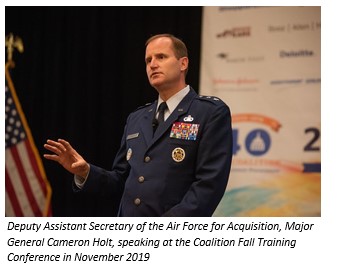The Procurement Process Challenge: To Stop Enabling Our Existential Threat
The Deputy Assistant Secretary of the Air Force for Acquisition, Major General Cameron Holt, is no stranger to Coalition members. During our last fall training conference before the pandemic hit our shores, General Holt took to the podium and provided attendees with a discussion of his vision for bringing innovation to the procurement system. He also stayed behind after his address to listen to Coalition members discuss the challenges they face in the acquisition process. By so doing, he led by example, demonstrating a commitment to the government-industry collaboration needed to bring about positive systemic change.
discuss the challenges they face in the acquisition process. By so doing, he led by example, demonstrating a commitment to the government-industry collaboration needed to bring about positive systemic change.
Fast-forward two years, and it is apparent that General Holt’s mission has not been slowed down by the pandemic. In a presentation before a recent Government Contracting Pricing Summit, he set out not only the impediments to efficiency in procurement, but also the underlying, existential threats that make addressing those impediments hyper-critical. His presentation can be found here, and although, to some extent, it is not for the faint of heart, it should be required viewing for all stakeholders in the procurement community and beyond.
From a system standpoint, General Holt points to bureaucratic process delays that inject time and cost into the acquisition cycle. He identifies the challenges associated with obtaining and sustaining program budgets, including the uncertainty of funding as stages of a program progress to a point in time where, for contractors, the program’s profitability is anticipated. General Holt also makes note of something with which we are all too familiar, specifically, what some of us have called the compliance checklist nature of contracting, that is, the many activities associated with meeting the regulatory burden layered into the procurement process. All told, these challenges impact the attractiveness of the federal marketplace and future contractor participation in that marketplace. To counteract those impacts, he points to his organization’s own innovative efforts to reduce procurement burdens by streamlining regulations and processes, returning rationally based discretion to contracting people, and supporting those people organizationally and through training.
In describing the nation’s “slow/micromanaged Cold War resource system,” as “the number one obstacle to us competing and … developing a very strong military deterrent and strategic overmatch…,” General Holt offers the stark reality that must motivate systemic change: the existential threat of China. He points out that the procurement system plays directly into addressing the threat from China. “China is … about five to six times faster than us in acquisition, and in purchasing power parity, they spend about one dollar to our 20 dollars to get to the same capability,” he said. Regarding the sustainability of this model, the general does not mince words, stating, “We are going to lose if we can’t figure out how to drop the cost and increase the speed in our defense supply chain. It’s a mathematical certainty.”
Decade after decade, the Coalition has joined other stakeholders in their efforts to streamline and rationalize the procurement system. The Coalition’s mission, to advance common sense in government procurement, speaks to our focus on efficiency, ease of use, growth in the innovative industrial base, and promotion of the government’s collaboration with its industry peers. Like others, we have supported modern acquisition reform efforts, notably using commercial terms, conditions, products, and services to allow the government to leverage the research and development expenditures and prowess of the commercial market while freeing precious taxpayer dollars for use where needed to fulfill government-unique needs.
Today, the world is different. No longer is procurement reform just about efficiency; more than ever it is a critical to our national security. The strength of our national security hinges on making the government market attractive to innovators, thereby expanding the government’s industrial base to meet current and future challenges. One way to expand the base is to make the market as familiar to those innovators as possible, reducing the need for processes asynchronous to their main businesses. So too, programs should be funded in a manner that allows planning, predictability, and flexibility to adjust to changing circumstances. Finally, making the government market attractive to innovators also requires focusing on the fundamental purpose of the procurement system, that is delivering best value services, solutions, and products to support the Federal mission on behalf of the American people.
General Holt’s presentation is a wakeup call. That the conversation is underway is good. That it continues and produces results (quickly!) is imperative.